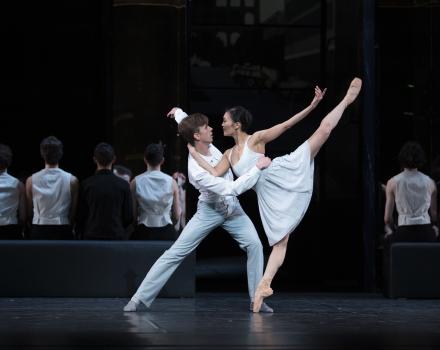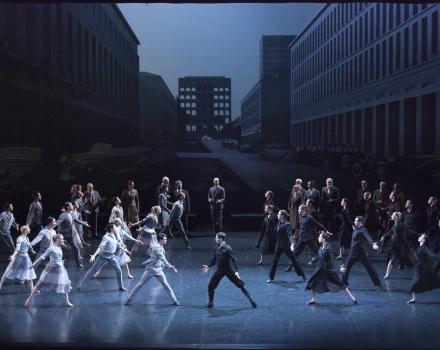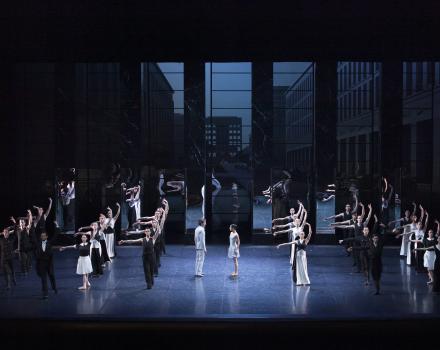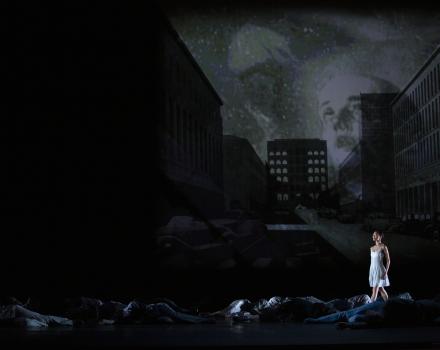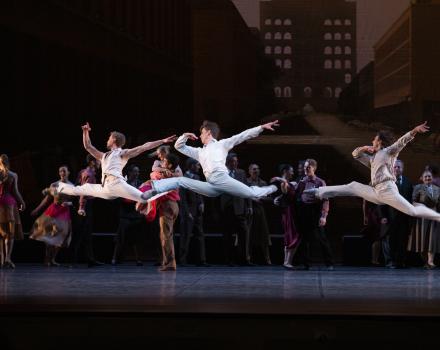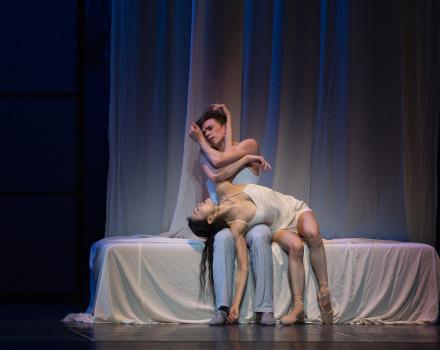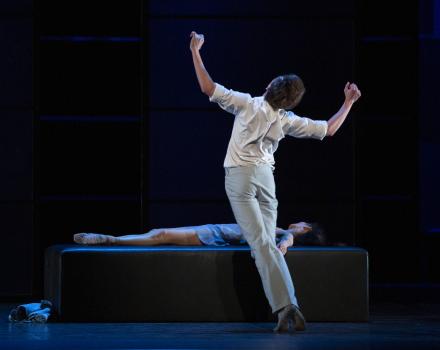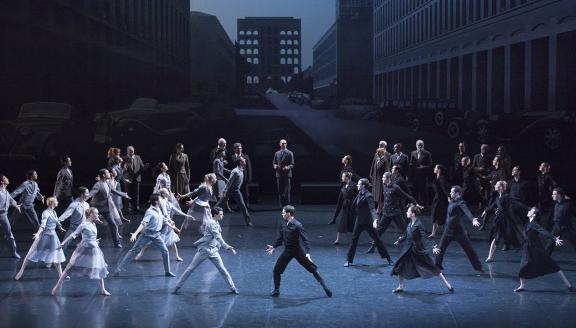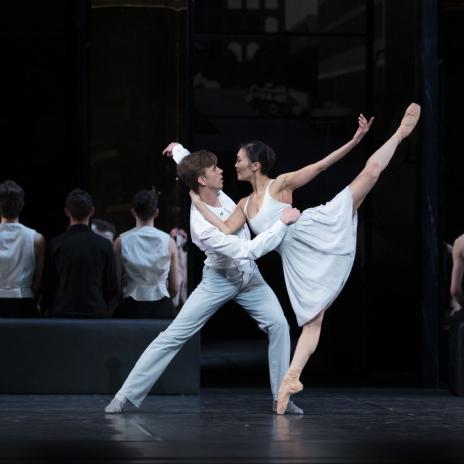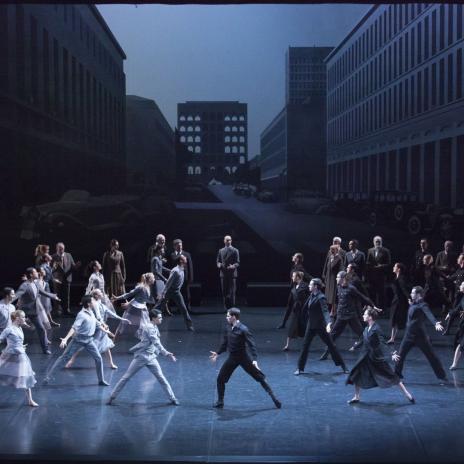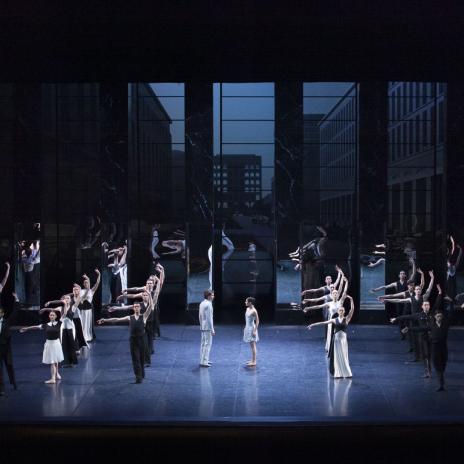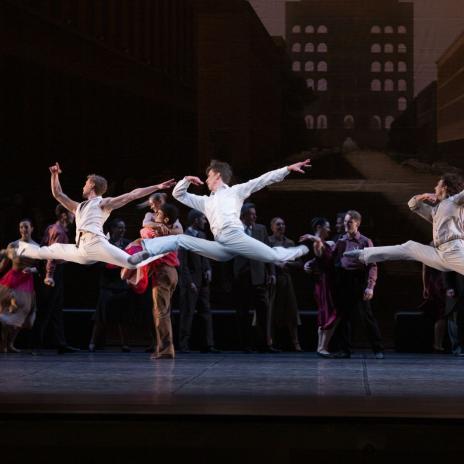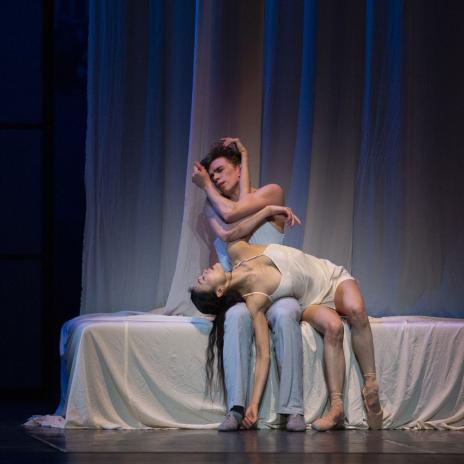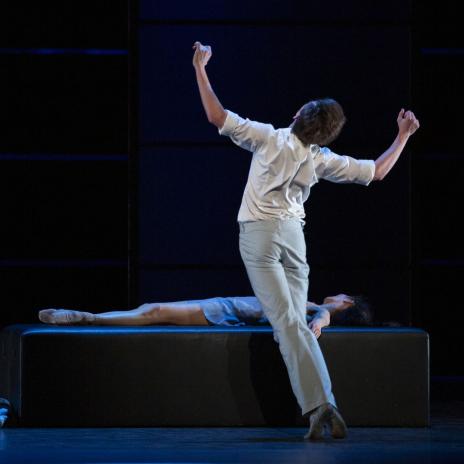

Two young lovers, offspring of the feuding Montague and Capulet families, value feelings above the past, pitting love and forgiveness against hatred and revenge.
Upon his return from exile in 1936, Sergei Prokofiev transformed Shakespeare’s famous tragedy into a ballet with a happy ending. Soviet cultural officials did not agree, so Romeo and Juliet went on dying as before. In his Warsaw staging, Krzysztof Pastor relocates the action to the Italy of the 1930s, 1950s and 1990s respectively – proving yet again the timeless nature of this tragic story.
Cast
|
Juliet Capulet
|
Yuka Ebihara
|
|---|---|
|
Romeo Montague
|
Patryk Walczak
|
|
Mercutio
|
Dawid Trzensimiech
|
|
Tybalt
|
Maksim Woitiul
|
|
Lord Capulet
|
Marco Esposito
|
|
Lady Capulet
|
Ana Kipshidze
|
|
Benvolio
|
Rinaldo Venuti
|
|
Friar Laurence
|
Carlos Martín Pérez
|
|
Juliet's Friend No. 1
|
Emilia Stachurska
|
|
Juliet's Friend No. 2
|
Mai Kageyama
|
|
Paris
|
Kristóf Szabó
|
| ... | |
|
Music
|
Sergei Prokofiev
|
|---|---|
|
Text
|
Krzysztof Pastor, Willem Bruls after William Shakespeare
|
|
Dancers
|
Polish National Ballet
|
|
Orchestra
|
Orchestra of the Polish National Opera
|
|
Choreographer
|
Krzysztof Pastor
|
|
Conductor
|
Andriy Yurkevych
|
|
Set and Costume Designer
|
Tatyana van Walsum
|
|
Dramaturg
|
Willem Bruls
|
|
Choreographer's Assistants
|
Kalina Schubert, Anita Kuskowska, Walery Mazepczyk
|
|
Lighting
|
Bert Dalhuysen
|
|
Film
|
Ewa Krasucka
|
| ... | |
Video
The story
Act 1
Scene 1
A street in Italy, sometime in the 1930s. Two rival families, the Capulets and the Montagues, dominate city life, but their feud seems to have calmed for the moment. Everyone takes part in the ritual evening walk. A sudden commotion occurs as a group from the Capulet family crosses the street, threatening to disrupt the evening’s harmony. Romeo and Benvolio and their friend Mercutio watch but decide to keep their distance for now. Capulet and Tybalt, the leaders of the Capulet group, also appear. The tension seems to rise again between the two families and a fight is unavoidable. Friar Lawrence appeals for them to stop, warning them about the possible tragic consequences of such public aggression.
Scene 2
Juliet, accompanied by her friends, prepares herself for the upcoming ball. It will be her first introduction into the world of the adults and her mother is worried about her daughter’s oncoming departure from childhood and the innocence it guards. Tybalt and other invited guests from the Capulet family arrive and are welcomed by Juliet’s mother. Romeo, Benvolio and Mercutio, who were not invited, sneak into the ballroom. Lord Capulet enters the ballroom and at once the guests are overwhelmed by his dominant presence. Romeo and Juliet see each other for the first time and there is an obvious attraction between them. Juliet’s father persuades her to dance for the other men, he is looking for a suitable husband for her. Tybalt, seeing that Romeo is fascinated by Juliet, decides to intervene, but Mercutio, who has also witnessed Romeo’s attraction, deflects Tybalt’s actions to protect his friend.
Romeo and Juliet seek each other out, and, when they finally manage to steal a moment alone, Romeo asks Juliet to dance for him. At first she dances in the same way she had for the other men, but this is not what Romeo wants – he wants her to trust him. The two are falling in love with each other but as this would be anathema for both clans, Capulet and Tybalt turn against Romeo and he and his friends are thrown out of the house. Later, outside of the Capulet house, Romeo comes to find Juliet and when they meet they confess their love for each other. They eventually part with the ominous feeling their families, deadly rivals as they are, will never approve of their love.
Act 2
Scene 1
A street in Italy, sometime in the 1950s. Every-one takes part in the ritual evening walk. As the Capulets parade Mercutio and Benvolio are leading the Montagues in a festive mood. Romeo is wandering around aimlessly – he is in love with Juliet. He is excited to receive a message from Juliet’s friends. She will meet Romeo with Friar Lawrence.
Scene 2
Despite his reservations, Friar Lawrence unites the two in a secret wedding ceremony.
Scene 3
Again the people fill the street. The Capulets, led by Tybalt, march by. The tension is rising again. Romeo interrupts an argument between Tybalt and Mercutio. He wants to maintain the peace, but they start to fight with each other anyway. Tybalt kills Mercutio, stabbing him in the back. Desperate and enraged, Romeo attacks Tybalt and dispatches him in a lethal duel. Both families watch.
Act 3
Scene 1
Italy, sometime in the 1990s. The lovers have spent the night together in Juliet’s bedroom – their only oasis in a forbidden love. The real world, however, continues to pervade their private space and Romeo is haunted by his slaying of Tybalt. Juliet absolves him, but eventually Romeo must leave. Juliet’s mother enters the room - the day has come when Juliet is expected to announce her decision as to whom she will marry, and both women are anxious. Juliet’s father enters, accompanied by several men, each a possible suitor for Juliet’s hand. She is required to dance for them once more and this time she is even more distraught. Her father and the men leave the room and Juliet is left once more alone with her mother. Inconsolable, she begs for her mother’s help, a way out to escape this sentence imposed by her father, but her mother is duty bound by her name and cannot help. Juliet realises she must seek the help of Friar Lawrence, possibly her only hope.
Scene 2
Juliet is driven to despair. At her rendezvous with Friar Lawrence, he suggests that she takes a potion that will put her in a long death-like sleep, explaining that if her family and friends discover her lifeless body they will assume she is dead, and she will be free of her bounds. Juliet agrees and the Friar promises he will tell Romeo of this deception so that he may join her and they can escape to be together. Left alone, Juliet swallows the potion and faints. She is discovered by a group of friends and family who at once begin to grieve her death.
Epilogue
Friar Lawrence has been unable to deliver the message to Romeo in time. Romeo returns to discover Juliet’s body and, believing she is dead, is consumed by grief. If he cannot be with her, he does not want to live. Clutching the dagger he used to kill Tybalt, he plunges it into his chest and dies beside her. As Juliet awakes from her sleep, her eyes focus on Romeo’s lifeless body. Her true love has been taken from her and with a deep longing to be with her husband for one last, eternal time. She takes Romeo’s dagger and takes her own life. Both families, touched by grief, prepare the bodies for burial.
Krzysztof Pastor and Willem Bruls
Insights
‘Ballet can force us to stop and think’
Choreographer Krysztof Pastor in conversation about Romeo and Juliet
How are the tragic lovers from Verona like us?
They are a symbol of doomed love. And each and every one of us has experienced such love...
Romeo and Juliet are a symbol of love thwarted mainly by their conflicted families.
Yes. The original problem stems from hatred between two families and that’s why to me this is chiefly a story about conflict. Conflict is a key word for me in this production.
Does this mean it isn’t just a sentimental tale of great romantic love?
No. Or at least not only. To me it’s not love that is the most important here. I avoid a sentimental and mawkish interpretation of this piece. In my work I focus on analysing where the conflicts lie.
You have tried to bring the story very much up to date.
Yes. I moved the setting to 20th-century Italy. I think Shakespeare is still so relevant because he can tell a story of 16th-century Verona but also comment on our times. The story will unfold in the 1930s, 1960s and 1990s. It will touch on changes that occurred in Italy. But I hope it will be clear that it’s really about the changes occurring in today’s world in general.
Some people are sure to say you’re breaking with tradition, that it’s not Shakespeare...
It’s not my intention to cause outrage. However, I realize this might happen because for some people, the ballet should be staged classically, nicely and without extravagance. Prokofiev’s music is brilliant. Shakespeare is brilliant. Their genius lies in the fact that they are still relevant. I simply want to show how well the story fits our own situation. I want to speak to ordinary people struggling with their everyday problems. I can’t imagine myself staging Romeo and Juliet these days with dancers in tights rushing around brandishing ‘toothpicks’, i.e. swords. [laughs] I think this way is more honest towards the audience.
As a choreographer, you often work with a dramaturg. Why?
Exactly because I want to create a cohesive story that is told through dance. There are no words in ballet. The plot is told outside words. That doesn’t mean there isn’t one, you have to create it based on the original story. That’s why I seek help from professional dramaturg Willem Bruls. It was with him that I ‘transcribed’ this play into movement, dance and stage sets.
I admit that I intentionally invited someone without any connection to ballet to work with me. I wanted that person to have a completely unballetic approach, not to have any of those ballet mannerisms. Bruls is an opera dramaturg so he has a fresh outlook on ballet. It was he, for instance, who showed me how valuable it was to have moments of ‘motion silence’, when a dancer is completely still. This fits in with my idea that a dancer doesn’t have to dance the whole time in order to express something. You can express a great deal with a pause, with stopped motion.
Reinventing Shakespeare, did you have a lot of freedom?
In ballet we have greater interpretative freedom than, for example, in opera. Here, we don’t use the spoken word, so you don’t feel the deviations from the text. Staging this ballet, we are reinterpreting Shakespeare, but because we don’t use words we leave a great deal of room for interpretation by the audience.
Why have you set the first act of Romeo and Juliet in the 1930s crisis in Italy?
I want to show how fascism emerged from fears caused by the crisis. Instead of setting the plot in the 16th century in Verona, I’ve placed it in 20th-century Italy during the crisis. It’s a good space for portraying two conflicted families.
And yet the optimism of the 1960s also appears in your interpretation.
Act two is a story about a brief moment of stability. The 1950s and 1960s in Italy were a time of enormous optimism. The Italians said, ‘the war and unhappiness is over, now we’re moving forward. Industry is developing, things are colourful, we ride Vespas. We’re living life to the full’.
Act three is the 1990s – an interesting choice.
The 1990s in Italy are the times of Berlusconi, a man who also practises a form of violence: media violence. He became a media tycoon and thus took possession of Italy. That was when something we can see so clearly today began: politicians’ cheap populism bringing huge harm to society. The infamous ‘bunga bunga’, hubris, impunity, it all originated in the 1990s.
But for many people ballet is supposed to be beautiful, romantic… and to mean little.
And female dancers are meant to glide gracefully in alluring tulle dresses? [laughs] Ballet is supposed to be pure aesthetic pleasure. That’s a misunderstanding! Ballet can also force us to stop and think. Ballet shouldn’t be just decorative.
How do you search for deeper meaning?
Let’s say we have the bedroom scene. In a traditional performance it would go like this: Romeo awakens, gets up, looks right, looks left, runs to the bed, grabs the girl and lifts her up. I can’t do that! It’s not my style. To me it’s more important to show that Romeo wakes up next to the woman he loves. Of course something happened between them. There was sex. And the night before, he killed a man. And now what? Is he supposed to glance around, lift up the girl and then flee because it’s light? I’m convinced that’s not how Shakespeare envisaged it. In my interpretation Romeo is happy and miserable at the same time, he spent the night with the gorgeous girl he’s madly in love with. Things most likely went wonderfully, but he feels the burden of murder weighing him down.
In your interpretation, are the characters stuck in a vicious circle of helplessness and hatred?
Yes. They have conflict in their genes, because conflict is something you inherit. In this sense, we are determined by the past. In my interpretation, there is a continuous cycle of violence, and the lovers cannot escape it. Looking at Romeo and Juliet, it might seem that the death of the children should end the conflict. But it doesn’t. Showing love in the context of this conflict underlines, highlights it, and shows just how risky it is.
So it’s a love story without a happy ending?
There is no happy ending. But you have to live with that somehow. The ending of the drama is very important. In Shakespeare, the two families gather over the bodies of their children. Something like reconciliation occurs. There’s none of that in my interpretation. Because the conflict continues.
The interview was conducted by Anna Kaplińska-Struss.
Gallery
